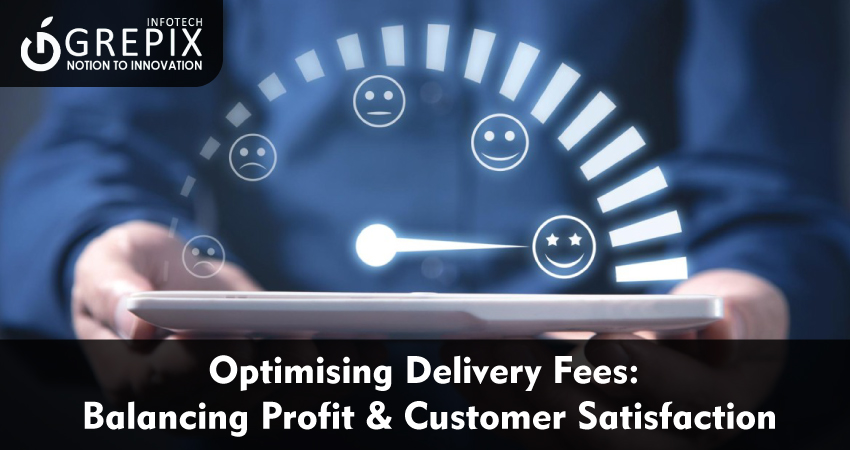Optimising Delivery Fees: Balancing Profit & Customer Satisfaction
Optimizing food delivery fees is a vital lever for balancing profitability and customer satisfaction in today’s competitive digital food landscape. Businesses need to ensure their delivery pricing strategy is dynamic, transparent, and efficient while considering cost factors and market trends. Success means using a robust food delivery profit model, leveraging technology, and prioritizing customer satisfaction pricing. This article covers actionable insights, proven case studies, and practical steps to help food delivery platforms and restaurants excel in food delivery fees optimization.
Food delivery fees optimization is essential for profit and customer retention in the competitive food delivery sector. With mounting costs from fuel, labor, and platform commissions, restaurants need strategic delivery pricing that’s transparent, zone-based, and data-driven. Technology route optimization, automation, and AI-powered analytics cuts costs and enhances customer experience. Real-life success stories and statistics prove that defining clear zones, promoting direct ordering, and using hybrid models effectively balance cost and satisfaction. Transparent communication of fees further amplifies trust. Applying these best practices ensures sustainable growth and long-term competitiveness in the fast-evolving world of food delivery.
The Importance of Delivery Pricing Strategy
Driving Revenue and Controlling Costs
- A carefully crafted delivery pricing strategy directly influences profitability and customer retention.
- Restaurants partnering with delivery apps report a 42% average revenue increase in the first year, underscoring how fees and pricing models drive growth.
- The market’s largest segment, Restaurant-to-Consumer delivery, is projected at $1.89 trillion by 2029, making it essential to balance cost and customer value.
Building Customer Trust and Loyalty
- Transparent and fair fees help customers perceive greater value, making them more likely to order again.
- High commission rates from third-party delivery platforms (often 15%–30%) can pressure restaurants to adjust their food delivery pricing strategy and delivery fees for sustainability.
Key Cost Factors in Food Delivery Fees Optimization
Direct Cost Drivers
- Fuel costs increase with delivery distance and route complexity.
- Labor charges, especially for longer or peak-hour deliveries, add to expenses.
- Vehicle maintenance, insurance, and other operational expenses affect the overall food delivery profit model.
Third-Party Commissions
- Platforms like Uber Eats or Zomato charge between 15% and 30% commission per order.
- These fees push most restaurants to set higher delivery charges or service fees for platform orders.
Delivery Zone Management
- Zone-based fees, such as charging $2.99 for 0–3km, $3.99 for 3–5km, and $4.99 for 5–7km, help match actual costs to pricing while maintaining competitiveness.
- Bulk purchasing and menu optimization (focusing on dishes that travel well) can reduce costs by up to 30%.
Delivery Zone Pricing
| Zone | Fee | Minimum Order |
|---|---|---|
| 0–3 km | $2.99 | $15 |
| 3–5 km | $3.99 | $20 |
| 5–7 km | $4.99 | $25 |
| 7+ km | Custom | $35 |
Technology and Automation Costs
- Cloud-based solutions reduce IT infrastructure costs and scale operations efficiently.
- Automation in order management, route optimization, and inventory tracking cut labor and delivery overheads.
Customer Perception: Impact of Pricing on Satisfaction
Price Sensitivity and Value Perception
- Research reveals that pricing perception is the single strongest predictor of customer satisfaction in food delivery.
- Customers expect transparent delivery fees, minimal hidden charges, and occasional promotions for repeat loyalty.
- Promotional pricing (discounts, free delivery over a certain order value) plays a significant role in boosting repeat sales.
Real-Life Case: Foodpanda Malaysia
- Delays, inconsistent quality, and pricing confusion lead to customer dissatisfaction.
- The survey showed pricing perception and delivery experience as the biggest drivers for loyalty, more than menu variety or promotions.
Psychological Influence
- Customers equate delivery fee fairness with overall brand reputation.
- Price increases are accepted if openly justified by improved speed, order accuracy, or enhanced communication.
Technology for Food Delivery Fees Optimization
Route Optimization
- AI-driven route planning can reduce delivery-related losses by up to 18% in six months, as seen with a burger joint in Chicago.
- Route algorithms minimize fuel consumption, reduce delays, and cut cost-per-delivery.
- Tools such as AWS Dynamic Delivery Planner and cloud-based POS integrations automate best routes for every order.
Dynamic Pricing and Real-Time Adjustments
- Dynamic pricing strategies adjust fees based on demand, time, and delivery distance for profit maximization.
- Data analytics identify high-value segments, peak demand periods, and inform targeted pricing adjustments.
Example List: Technology Benefits
- AI-powered price recommendations based on market demand.
- Real-time route optimization for faster, cheaper deliveries.
- Cloud-based analytics for tracking cost and customer trends.
- Automated fee calculation based on zones and order value.
Best Practices for Food Delivery Fees Optimization
Define Delivery Zones and Tiered Pricing
- Setting clear delivery boundaries and tiered fees matches cost to price, controls losses, and improves transparency.
- Use software to automate calculations and display easy-to-understand maps on platforms for customer convenience.
Use Hybrid Delivery Models
- Combine in-house and third-party delivery to save up to 30%, reducing dependence on platforms while maximizing reach.
- Direct ordering systems avoid 15–30% commission fees from platforms, leading to better margins and closer customer relationships.
Promote Direct Orders Over Platforms
- Incentivize customers to order directly (e.g., lower fees, loyalty programs, or bundled meal deals).
- Adjust menu prices across channels so customers see the benefit of direct ordering.
Bulk Purchasing and Inventory Management
- Buying supplies in bulk and maintaining tight inventory control reduces food and packaging costs by 10–30%.
- Synchronize POS systems with inventory and delivery software to decrease errors and streamline operations by 15–20%.
Transparent Communication
- Show all fees upfront in the ordering process and receipts.
- Create clear policy and FAQ sections around fees, zones, and minimum orders.
Technology Investments
- Invest in route optimization software, cloud-based solutions, and data analytics for ongoing improvements.
- Use automation to reduce labor costs, speed up delivery, and adapt pricing in real-time.
Best Practices Checklist
- Define zones and tiered fees.
- Automate delivery routes and fee calculations.
- Promote direct orders.
- Use hybrid delivery models for cost control.
- Manage inventory and supplies efficiently.
- Communicate pricing and policies openly.
Case Studies and Examples
Burger Joint in Suburban Chicago
Implemented distance-based delivery fees, automated route planning, and delivery zone management. Result: Cut delivery losses by 18% in six months, improved customer satisfaction with clearer, fair pricing.
National Restaurant Chain
Deployed direct ordering platforms alongside third-party services. Avoided 15–30% commissions, increased direct customer base, boosted profit margins, and retained loyal customers with transparent fee structures and rewards for direct orders.
AI-Powered Dynamic Pricing Platform
Adopted PROS Smart Price Optimization and Management software. Centralized pricing data, delivered AI-powered price recommendations, and tracked cost and margin trends. Outcome: Real-time fee adjustments increased multi-channel sales and optimized profits across channels.
Conclusion
Optimising food delivery fees requires a deep, strategic approach blending cost control, technological innovation, and customer-centric pricing models. Restaurants and platforms maximizing their food delivery profit model achieve not only financial sustainability but also loyal, satisfied customers. Zone-based pricing, bulk purchasing, direct order incentives, and automated route planning drive consistent profit while meeting customer expectations for fair, transparent fees. Technology and AI analytics future-proof operations, enabling real-time adaptations to demand and route complexity. The key to success? Continually refine delivery pricing strategy, prioritize value perception, and communicate policies openly. Sharing this guide can help food business owners optimize their own operations, ensuring growth, efficiency, and a superior delivery experience for every customer. Act now, review your food delivery fees optimization strategy, and join the ranks of leading food delivery businesses.
FAQs
1. What is the best food delivery pricing strategy for small restaurants?
Small restaurants benefit most from zone-based pricing, hybrid delivery models, and promoting direct orders to avoid high third-party commissions.
2. How do delivery fees impact customer satisfaction?
Transparent delivery fees and clear communication improve customer satisfaction; hidden or unfair fees increase complaints and reduce loyalty.
3. What technology helps optimize food delivery fees?
AI-powered route optimization, cloud-based POS integration, and data analytics software automate fee calculations and enable real-time pricing.
4. How can restaurants balance profit and customer satisfaction in food delivery?
Use tiered pricing, bulk purchasing, automate delivery routes, and promote direct orders. Always communicate fee policies clearly.
5. Why do most restaurants charge higher delivery fees on third-party apps?
High commission rates (up to 30%) from platforms force restaurants to increase fees, while direct orders allow for better pricing and margins.







